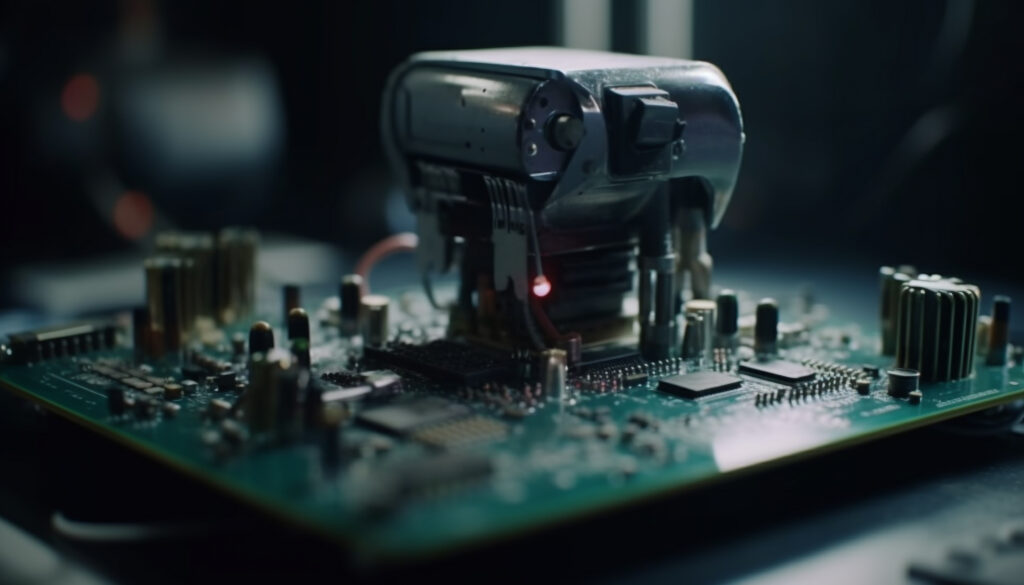Smart Factory Implementation: Boosting Efficiency in EMS
Harnessing IoT and AI for Smart Factory Success in EMS Industry In the rapidly evolving landscape of Electronics Manufacturing Services (EMS), smart factory implementation stands as a transformative force. By integrating advanced technologies such as the Internet of Things (IoT), artificial intelligence (AI), and robotics, smart factories are enhancing efficiency, productivity, and quality across […]

Harnessing IoT and AI for Smart Factory Success in EMS Industry
In the rapidly evolving landscape of Electronics Manufacturing Services (EMS), smart factory implementation stands as a transformative force.

By integrating advanced technologies such as the Internet of Things (IoT), artificial intelligence (AI), and robotics, smart factories are enhancing efficiency, productivity, and quality across the EMS sector.
Let us delves into the various aspects of smart factory implementation and its impact on EMS, highlighting key SEO keywords: smart factory, EMS, IoT, AI, robotics, automation, efficiency, Industry 4.0, data analytics, and sustainability.
Understanding Smart Factories
A smart factory leverages cutting-edge technology to create a highly digitized and interconnected production environment. The goal is to achieve a seamless and agile manufacturing process that can adapt to changes in demand and production requirements.
This transformation is a core component of Industry 4.0, the fourth industrial revolution, which emphasizes the use of digital technologies to revolutionize manufacturing and production.
Key Components of Smart Factory Implementation
Internet of Things (IoT): IoT devices play a crucial role in smart factories by enabling real-time data collection and communication between machines, systems, and humans.
These devices provide valuable insights into the production process, helping manufacturers optimize operations and reduce downtime. Artificial Intelligence (AI): AI technologies, such as machine learning and predictive analytics, are employed to analyze data collected from IoT devices and other sources.
AI enables smart factories to predict equipment failures, optimize supply chain management, and enhance product quality through continuous learning and improvement.
Robotics and Automation:
Advanced robotics and automation systems streamline manufacturing processes, reducing human error and increasing production speed.
By automating repetitive tasks, smart factories free up human resources for more complex and creative work.
Data Analytics: Data analytics is at the heart of smart factory implementation. By analyzing vast amounts of data generated by IoT devices, manufacturers can gain insights into production trends, identify inefficiencies, and make informed decisions to improve processes and outcomes.
Sustainability: Smart factories are designed with sustainability in mind. By optimizing resource usage and minimizing waste, these factories contribute to a more sustainable and environmentally friendly manufacturing process.
Benefits of Smart Factory Implementation in EMS Enhanced Efficiency
One of the most significant advantages of smart factory implementation is the enhancement of efficiency in EMS. By utilizing IoT and AI technologies, manufacturers can optimize production schedules, reduce lead times, and minimize machine downtime.
This leads to faster production cycles and improved on-time delivery rates, ultimately increasing customer satisfaction.
Improved Product Quality
Smart factories enable real-time monitoring and control of production processes, allowing for early detection and correction of quality issues.
AI-driven analytics can identify patterns and anomalies that may lead to defects, enabling proactive measures to maintain high product quality standards.
This results in fewer recalls and warranty claims, enhancing the reputation of EMS providers.
Cost Reduction
Automation and robotics reduce labor costs by performing repetitive and mundane tasks more efficiently than human workers. Additionally, predictive maintenance, powered by AI, helps prevent unexpected equipment failures and costly downtime.
The optimization of resource usage and energy consumption further contributes to cost savings in smart factories.
Agility and Flexibility
In today’s dynamic market environment, EMS providers must be agile and responsive to changes in customer demands. Smart factories enable quick reconfiguration of production lines to accommodate new product designs and variations. This flexibility allows manufacturers to stay competitive and meet evolving market needs effectively.
Data-Driven Decision Making
The abundance of data generated by smart factories empowers EMS providers to make informed decisions based on real-time insights. Data analytics provides a comprehensive view of production processes, supply chain dynamics, and customer preferences.
By leveraging this information, manufacturers can optimize their operations and develop strategies to drive growth and innovation.
Challenges in Implementing Smart Factories
While the benefits of smart factory implementation are substantial, there are challenges that EMS providers must overcome:
Initial Investment
The transition to a smart factory requires a significant upfront investment in technology and infrastructure. However, the long-term benefits in terms of efficiency and cost savings often outweigh the initial expenses.
Skill Gaps
Implementing and managing advanced technologies necessitates a skilled workforce. EMS providers must invest in training and upskilling their employees to effectively operate and maintain smart factory systems.
Cybersecurity Concerns
As smart factories become more interconnected, they also become vulnerable to cybersecurity threats. Ensuring robust cybersecurity measures are in place is essential to protect sensitive data and maintain the integrity of production processes.
Integration Complexity
Integrating diverse technologies and systems can be complex and time-consuming. EMS providers must carefully plan and execute integration strategies to ensure seamless communication and interoperability between different components of the smart factory.
Future Prospects
The future of smart factory implementation in EMS is promising, with continued advancements in technology driving further innovation. As IoT devices become more sophisticated and AI capabilities expand, smart factories will become even more efficient and autonomous.
The integration of digital twins, virtual replicas of physical systems, will enable manufacturers to simulate and optimize processes in a virtual environment before implementing changes in the real world.
Moreover, the focus on sustainability will continue to grow, with smart factories playing a pivotal role in reducing the carbon footprint of manufacturing processes. By embracing green technologies and energy-efficient practices, EMS providers can contribute to a more sustainable and environmentally conscious industry.
Smart factory implementation is a game-changer for the Electronics Manufacturing Services (EMS) sector, enhancing efficiency, product quality, and flexibility while reducing costs and environmental impact.
By leveraging IoT, AI, robotics, and data analytics, smart factories are driving the evolution of Industry 4.0 and shaping the future of manufacturing.
As EMS providers navigate the challenges of implementation, they must prioritize investment in technology, workforce development, and cybersecurity measures.The rewards of embracing smart factory technologies are significant, offering a competitive edge in a rapidly changing market landscape.
By continuously innovating and adapting to new technologies, EMS providers can unlock the full potential of smart factories and lead the way in the era of digital manufacturing transformation.


